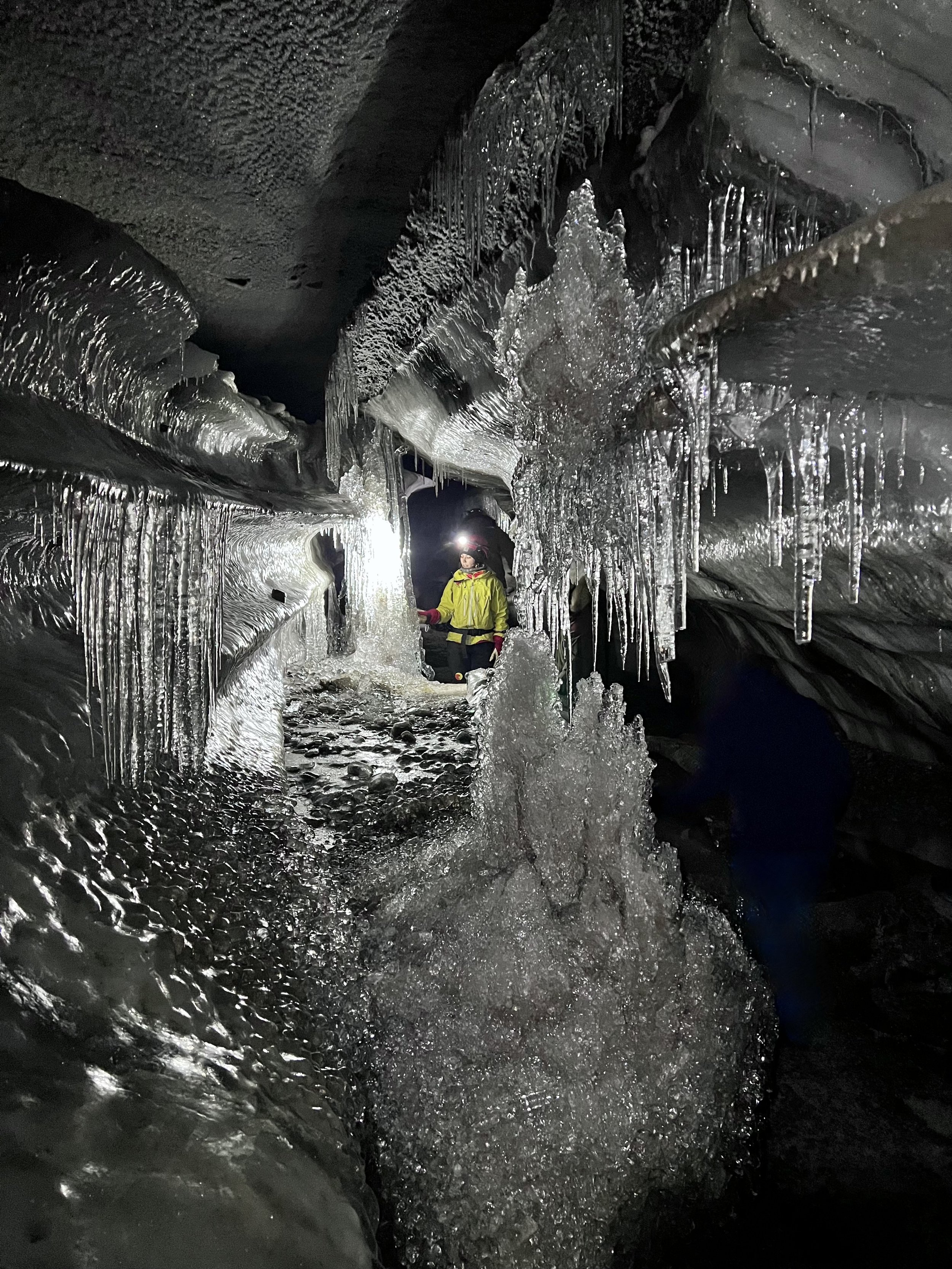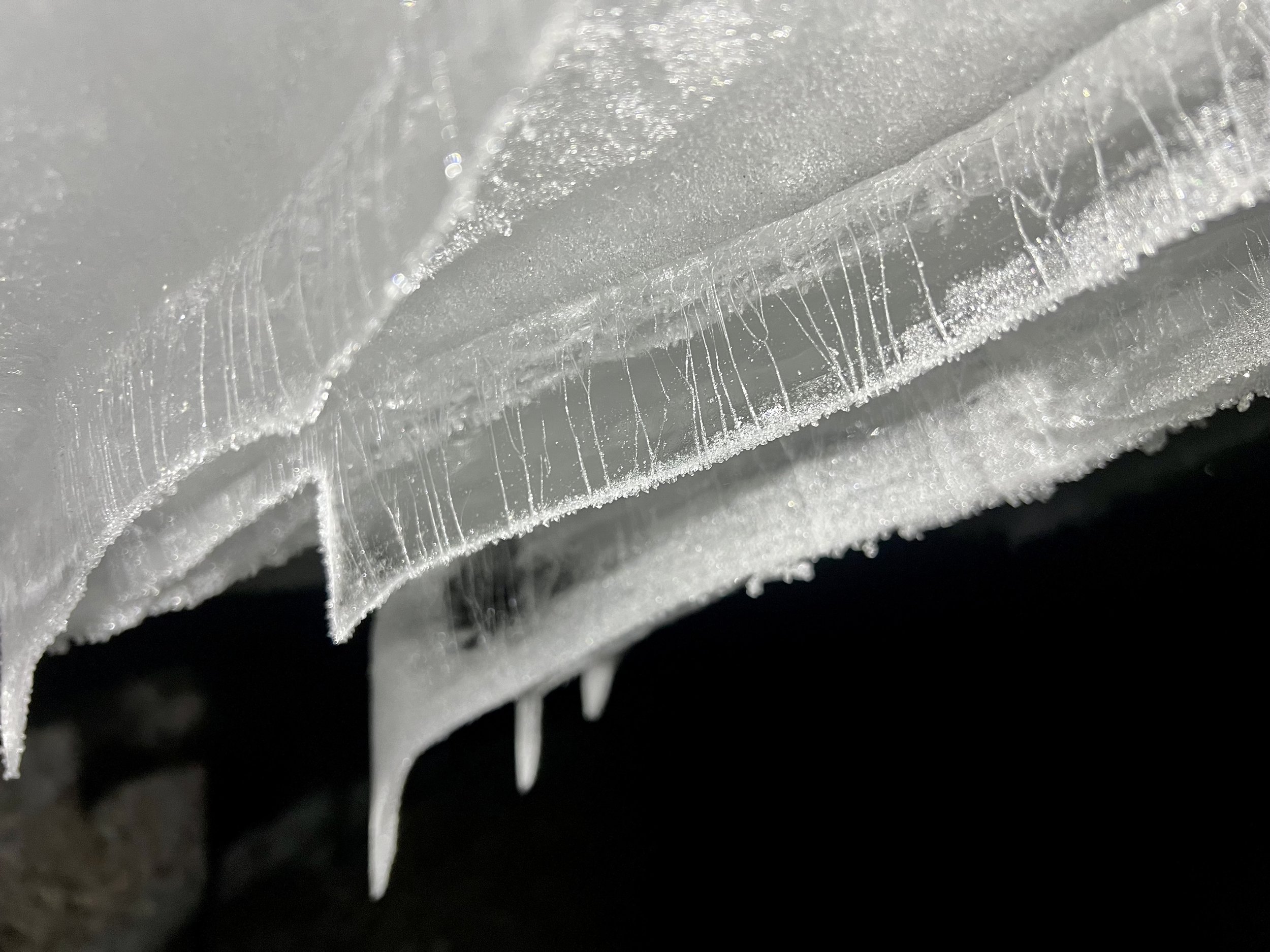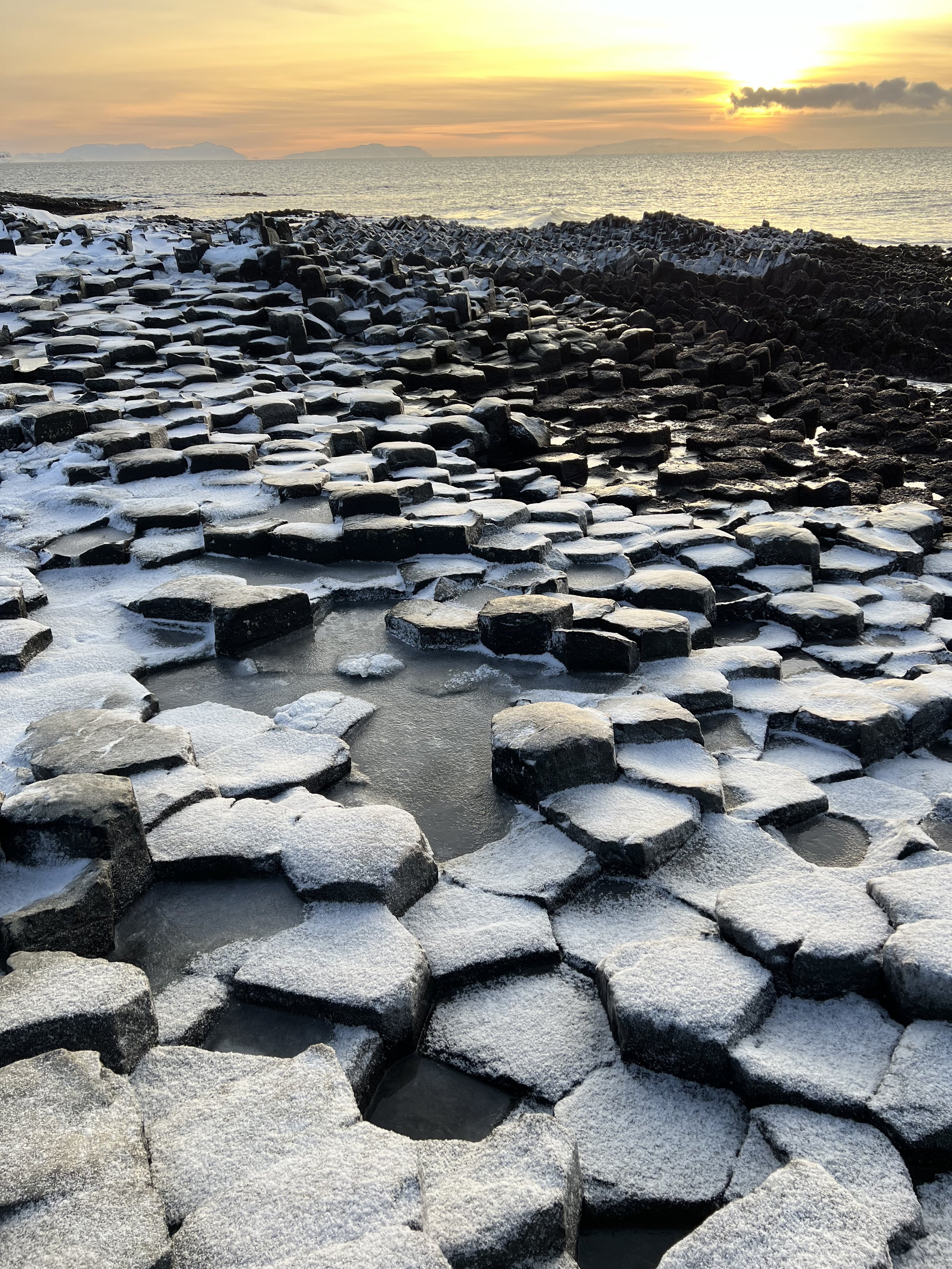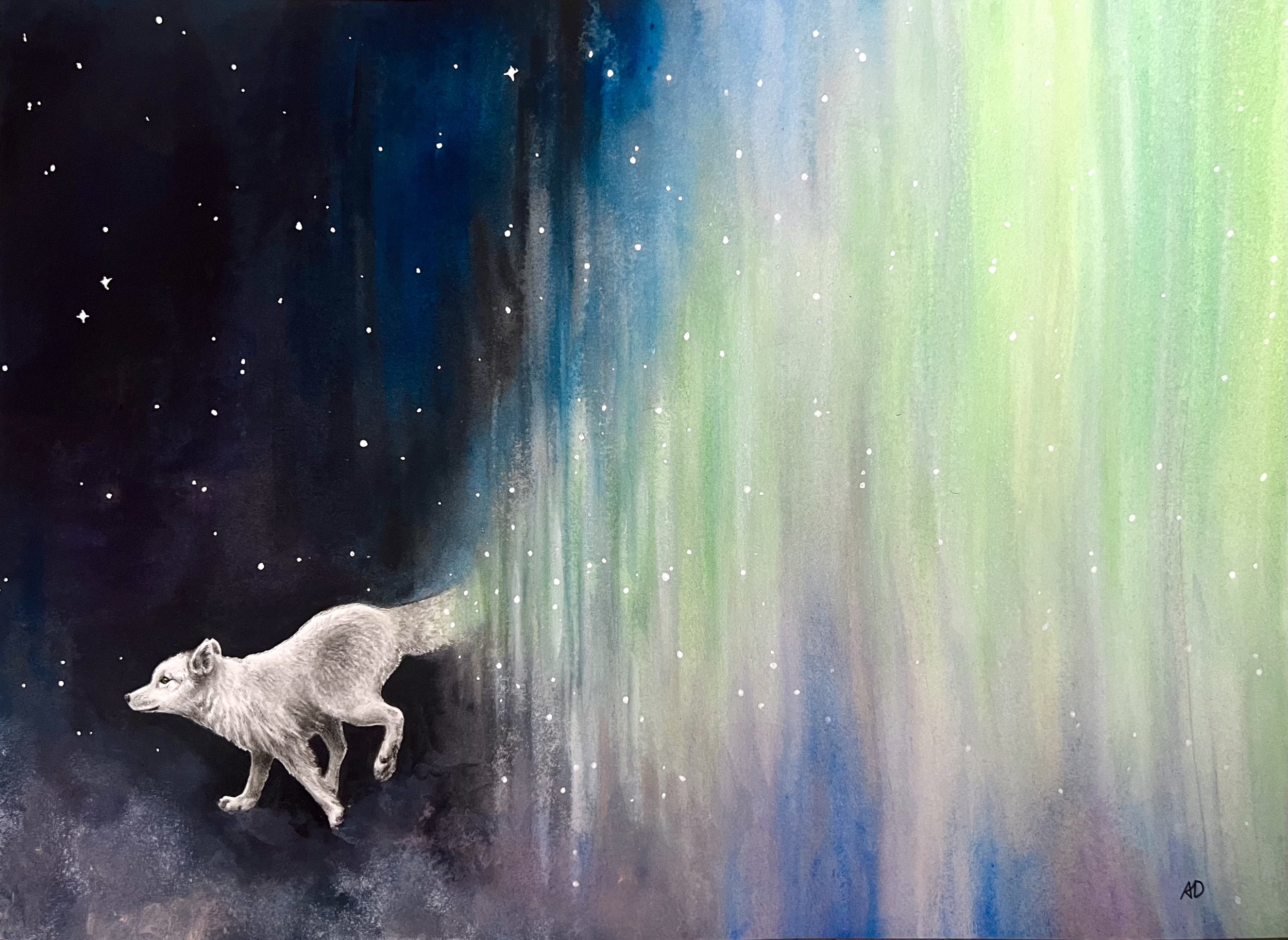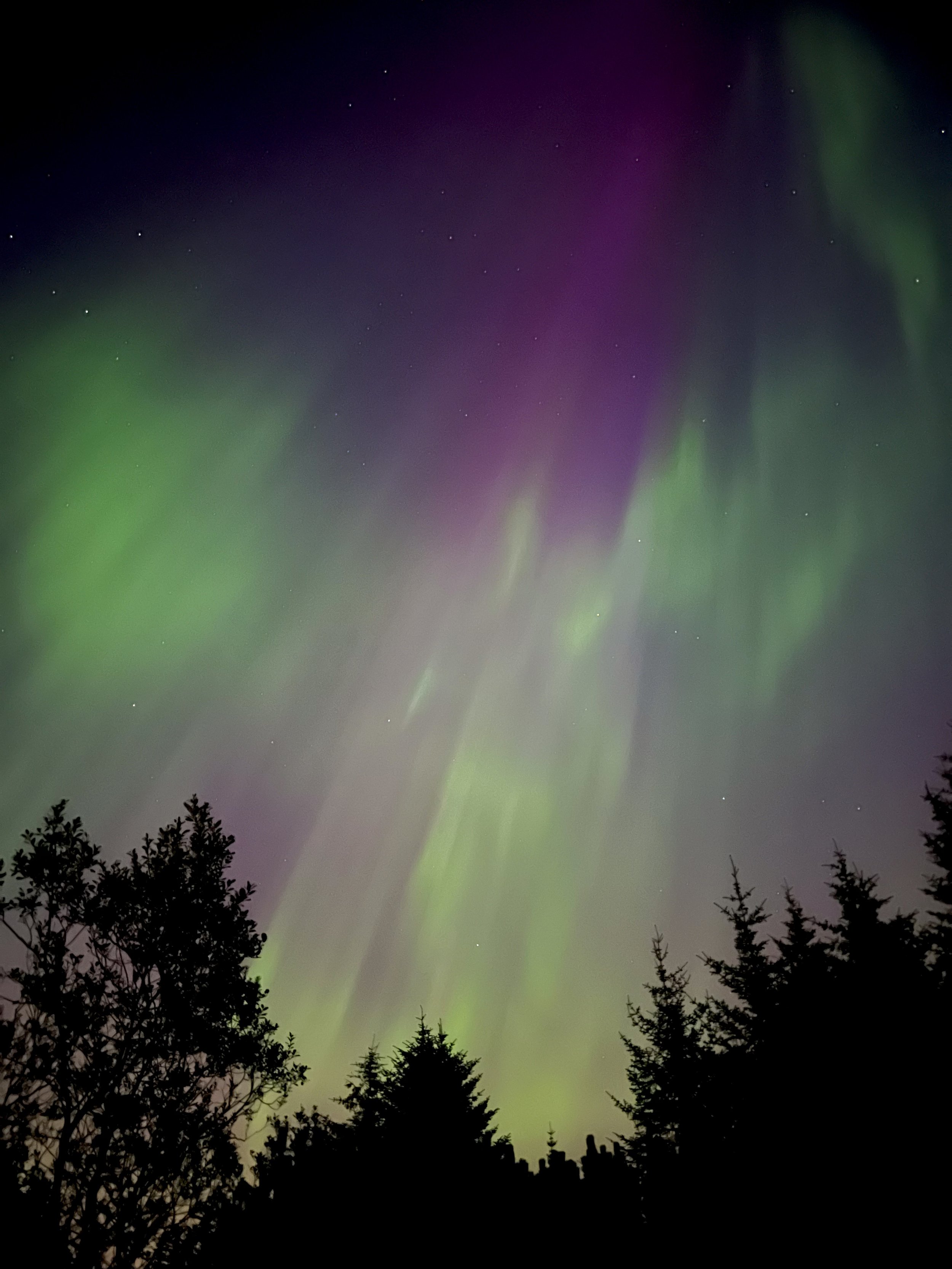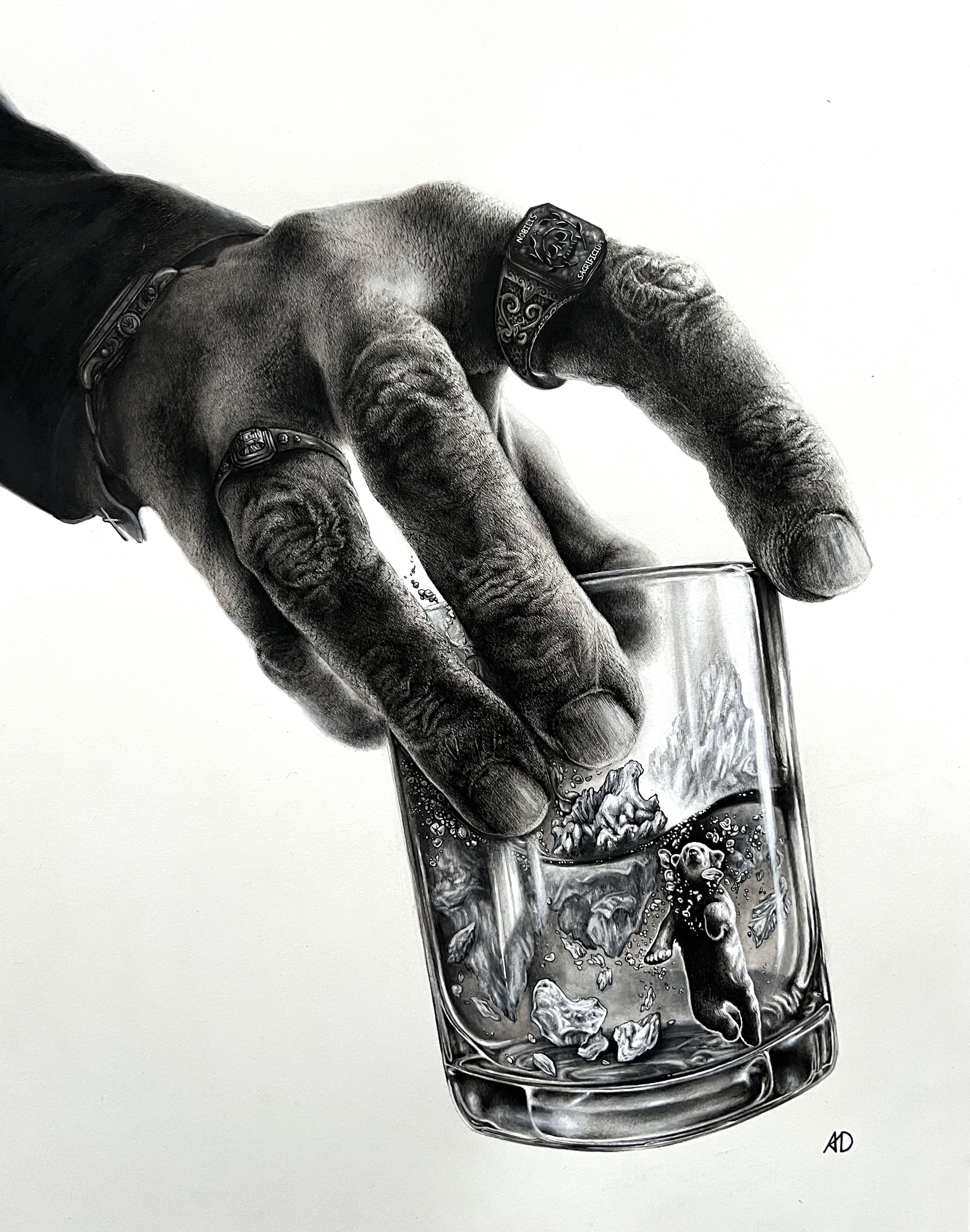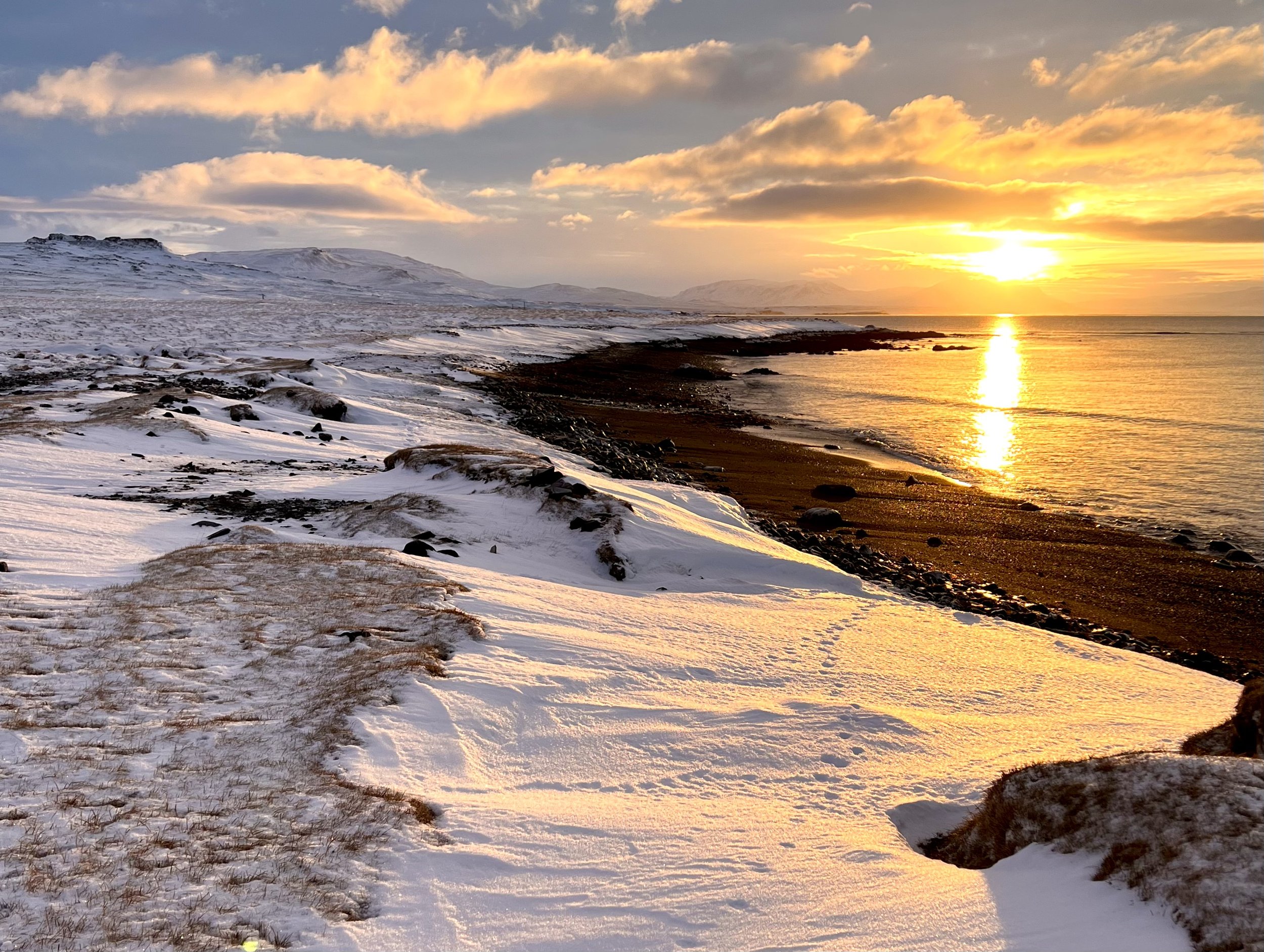Ice
Winter in the Arctic. There’s something so otherworldly about the glittering ice crystals, the blue shadows and pink highlights, the drama of the clouds obscuring the mountain peaks. It’s like nature fully takes over and says HEY look what I can do, and watch out! and isn’t it beautiful?!
People love to remind me that I’m bad at being cold when I tell them I’m going to the arctic…again… for the winter. But honestly that’s actually part of why I love it. It’s pure nature doing her thing, making no accommodations whatsoever for humans. If suffering makes you appreciate something more, maybe that’s what winter does for me. I like that I’m at nature’s mercy in winter, because it reminds me that she’s the boss. It’s awe-inspiring, and also humbling.
Arctic winter is humbling in an artistic sense as well. How can I possibly compete with the bubbles and fissures and deep blues of glacial ice? The golden glow of the low rising sun throwing a thousand sparkles over untouched snow? The snow laden branches and quiet stillness of a winter forest? I can’t compete, I can only pay tribute. Some things aren’t meant to be competed with or made better; only to be respected and admired. Nature is definitely one of those things, and I love the harsh northern winter for its not-so-passive reminder of that.
Ice caves are places of magic, but they’re fascinating from a scientific standpoint as well. As Arthur C. Clarke put it, “magic is just science we don’t understand yet.”
Ice caves are formed by meltwater rivers flowing underneath glaciers. Because glaciers move and are ever-changing, caves form and reform, leaving ice caves behind where there used to be a river. One of my favorite aspects of ice caves is their dynamic state; they change almost daily and are never quite the same.
Wonder why this cave isn’t blue? Contrary to popular belief, an ice cave differs from a glacier cave. Glacier caves form fully from the glacier, whereas ice caves are caves constructed mainly with other material, like rock, that has a substantial amount of ice in it.
But why are glacier caves blue? Although this is an ice cave, I’m gonna tell you because it’s neat. Glacier ice has been frozen a long time and is much harder and denser than the ice in your freezer. This is referred to as “pure ice”. Because of the mineral-like properties of pure ice, it absorbs red light and reflects blue light. Certain factors affect the blue color, like the amount of sunlight in the cave, whether there’s fresh snow on top, and how much air bubbles are in the ice.
But back to more ephemeral ice! My favorite aspect of ice caves are ice crystals (the details!). Ice crystals are found in four main structure types: stellar dendrites, columns, plates, and needles. The crystallization process is influenced by temperature, humidity, and impurities in the water, all of which determines their crystal structure.
Ice crystals are like natures jewelry, and wow is she an amazing designer! Finding this variety of ice crystal structures felt like entering an impossible world of ethereal, delicate sculptures; a garden of twinkling crystal and patterns. I’ve never been a huge fan of doing math myself, but these crystals are the perfect example of the beauty of math in nature.
Ice crystals are found in four main structure types: stellar dendrites, columns, plates, and needles. The crystallization process is influenced by temperature, humidity, and impurities in the water, all of which determines their crystal structure. While crystals grow in specific structures, no two are the exact same- at least, not down to the molecular level.
Ice crystal research is actually very important, and helps us understand climate conditions and weather in relation to climate change. Ice crystals, like my art, are also extremely detailed. They draw us in with their beauty and complexity, and remind us to really look at, and appreciate, the nature around us.
I hate to disappoint, but puffins are actually not the national bird of Iceland- that title goes to the majestic gyrfalcon. However, 60% of the world’s puffins breed in Iceland! They’re nicknamed “clowns of the sea” and “sea parrots”, but in Icelandic they’re “lundi”.
Puffins mate for life and produce only one egg per mating season. A baby puffin is called- get this- a puffling! Instead of building nests, they dig holes, sometimes even stealing rabbit burrows. Their distinctive bright orange beaks are only on show during mating season. Before winter, their outer beaks shed to reveal smaller, duller beaks.
Their beaks are for more than show though, and are serrated to help them secure their preferred prey of small fish and sand eels. Adult puffins need to eat about 40 small fish a day! Luckily, they’re excellent swimmers and can dive up to 60m and hold their breath up to a minute.
Puffins are very social and communicate mostly through body language. They can be very vocal while breeding, but are silent at sea, where they spend the majority of their time. Their biggest predator is the great black-backed gull, but they have many others as well. Puffins use a camouflage trick called countershading. This means that they are black on top- difficult to see from above- and white on the bottom- difficult to see from below. If they watch for gulls, puffins live a long time for seabirds- about 20 years!
I’m sure you’ve seen photos of Icelands famous black basalt columns, but do you know how they’re formed? Basalt is a volcanic rock that’s formed from superheated magma that emerges as lave during an eruption. As lava cools it contracts, and tries to form shapes that reduce stress. Hexagons are the most efficient way to achieve this while maintaining a consistent shape and minimizing surface area.
Basalt is very rich in iron and magnesium, and cools and hardens quickly once exposed to air. Depending on the specific mineral content, the structures vary from glassy to fine-grained. Commonly, they show a porphyritic texture with large crystals of olivine, augite, or feldspar in a fine matrix.
The ridiculously cute Svalbard reindeer is a subspecies of reindeer endemic to the archipelago. They are the smallest species of reindeer, and have adapted to the specific environment of Svalbard in several ways.
For example, their feet are shaped specially for digging in the snow for their preferred food, lichens and moss. Their noses are designed to retain moisture in this dry air, while heating the air going into their lungs. Their fur is incredibly dense and the individual hairs are hollow, which increases insulation. The female of this species grows antlers as well as the males, in order to defend the food territory she needs while she is pregnant.
While Svalbard reindeer have formerly had no natural predators, polar bears have begun hunting them as sea ice retreats and takes the opportunity for hunting seals with it.
The aurora, or nordlys, is created when energized particles from the sun slam into Earth’s upper atmosphere at speeds of up to 45 million mph. Earths magnetic field protects us from these particles by redirecting them toward the poles. These deflected particles interact with our atmosphere, depositing energy and causing the atmosphere to fluoresce. The colors of the aurora are dictated by the chemical composition of Earth’s atmosphere.
The aurora means different things to different cultures. In Greco-Roman mythology, Aurora is the personification of the dawn, and the sister of the sun and the moon. The ancient Greeks and Romans believed that every day Aurora raced across the sky in her chariot, alerting her brother and sister to the breaking of the new day.
In Finnish lore, the aurora is caused by a fox running so fast across the snow that its tail sparks flames up into the sky. They call the aurora “revontulet”, or fox fires.
The Samí people believe that the aurora’s lights are the souls of the dead, passing on to the next world. Samí mothers will entice their children to be inside before dark by telling stories of the aurora reaching her glowing fingers down to snatch them up.
Here in Iceland, the aurora is prolific in Norse mythology. The lights were believed to be the Bifröst, a rainbow bridge connecting Midgard (Earth) and Asgard (the home of the gods). Other legends claim that the shimmering glow is the reflection off the Valkyrie’s armor and shields. There’s plenty of superstition around the aurora as well, such as the belief that it soothes the pain of childbirth. However, if the laboring mother looks at the lights, then her child will be born crosseyed. Fishermen see the lights as the reflections off huge shoals of herring, a good fishing omen.
No matter what you see in them, witnessing the aurora is an incredible experience. The most rigid scientific minds can’t help but get swept away with the magic and wonder of it. Watching the lights dance fills you with gratitude to be living on this earth, and instills a deep love and respect for the planet we call home.
In Iceland, you can be banished from the island for calling the Icelandic horse a pony. …ok fine, not really, but you’d think so the way Icelanders feel about it! While Icelandic horses do meet the size requirements for a pony, their conformation and temperaments qualify them as horses. So what they lack in height, they make up for in spirit!
Their height is one of the many ways they’ve adapted to the harsh environment of Iceland. Shorter legs keep them lower to the ground and help them retain heat. In the winter they grow shaggy coats that insulate and protect from the elements. They also grow more ear and nose fuzz to protect their sensitive exposed areas, like us putting on gloves.
Icelandic horses are famous for having an additional two gaits along with the usual three; the tölt and the skeið. During the tölt, at least one hoof is always in contact with the ground. This helps stabilize the ride, and makes for a smoother riding experience. The tölt is especially useful as it helps these horses to easily navigate the rocky and uneven terrain of Iceland’s volcanic landscapes.
The skeið is a fast, or flying, pace that requires horses to perform a lateral gait – where both legs on one side touch the ground simultaneously. Performed at up to 30mph, there are points at which no hooves are in contact with the ground.
There are 80,000 Icelandic horses registered in Iceland. With a human population of 350,000, that’s about four people to a horse. The horses are kept strictly purebred, and can only leave the country once. For all that fanciness, the Icelandic horse is good-natured and friendly, resilient and hardy… much like Icelanders themselves!
It’s hard to capture the beauty of Svalbard in words. It’s a place of magic, raw nature, light and dark, energy and stillness. It’s also a rather heartbreaking place. Svalbard is being affected by global warming six times faster than the global average, and is, unfortunately, a prime example of the devastating effects of climate change.
This beautiful archipelago is strongly affected by Arctic amplification, a feedback mechanism where sea-ice retreat and atmospheric warming make each other worse. Furthermore, Svalbard’s glaciers are at low elevations, which make them more susceptible to warming. These factors, as well as others, are why its glaciers – which represent 6% of the planet’s glaciated area outside Greenland and Antarctica – are swiftly melting away.
C02 emissions, melting permafrost, loss of wildlife habitat, and increased rain and landslides are a few of the effects that have been steadily at a rise for years, and are now reaching a crescendo. It has been predicted that due to the buildup of constant devastation, by 2100 Svalbard’s glaciers could be losing ice at double the current rate… regardless of whether global climate targets are hit.
Much of the beauty of nature is ephemeral. A snowflake, the setting sun, a cherry blossom. But nature is not meant to become ephemeral, or to disappear entirely. When that happens, there is nothing beautiful in the loss. There is only tragedy and failure. When you are in a beautiful place, please take a moment to look around and truly appreciate it. Then take another moment to imagine it gone forever. We can’t just admire nature. It’s not there to please us. It’s not enough to appreciate it in the moment; we have to care about it’s future.
“To attain any kind of life in this universe of ours appears to be quite an achievement. As humans we are doubly lucky, of course: We enjoy not only the privilege of existence but also the singular ability to appreciate it and even, in a multitude of ways, to make it better. It is a talent we have only barely begun to grasp.” - Bill Bryson, A Short History of Nearly Everything
Some animals, like the apple snail, can live in many different types of ecosystems. But polar bears can only survive in one ecosystem- areas with arctic ice.
Unfortunately for polar bears, global warming is melting the ice they rely on at an alarming rate. The volume of ice in the Arctic has decreased by a third over the past twenty years, and the rate of decrease is accelerating. Climate scientists have suggested that by 2040, the arctic could experience an ice-free summer.
Polar bears rely on arctic sea ice to hunt. Their preferred prey, seals, live in the ocean underneath the ice. Without ice to roam on, polar bears can’t hunt seals, or any other life-sustaining prey. They also rely on the ice to breed, and sometimes to build dens. More than 96% of a polar bears critical habitat is sea ice.
So what does melting sea ice matter? Well, it does, and here are three reasons why:
1. Sea ice acts as a “blanket” that traps heat in the ocean and helps prevent atmospheric warming. Usually some sea ice survives the summer melt, and this ice gets compounded year after year, creating effective “multiyear ice”. Because that hasn’t been happening, the sea ice “blanket” that does form is thin, weak, and ineffective.
2. As you may have read in my previous posts, many animals depend on sea ice for habitat, breeding, and hunting; like polar bears and seals. However, it’s also vital to organisms on a micro level. The freeze-melt cycle generates a circulation of nutrients to the surface. These nutrients are essential to phytoplankton, which in itself is a keystone food source to many species and crucial to the ocean ecosystem and to the environment as a whole.
3. Changes in the amount of sea ice can disrupt normal ocean circulation, which in turn can effect the global climate. When sea ice forms, it traps the oceans salt near its surface, making the water beneath saltier and denser. The cold dense polar water sinks and circulates along the bottom of the ocean towards the poles, while the warmer, less salty water from the equator makes its way towards the poles. This is an earth system that has been in place for millennia, and is now being disrupted.
As a lover of entomology, one of the strangest things about being on Svalbard was that I didn’t see a single insect or bug in four months. Quite the drastic change from my treehouse in Ecuador, where I spent my days finding cool bugs everywhere before going to Svalbard! Are there even any invertebrates on Svalbard?
There are! Not a whole lot though. To give you an idea, Svalbard hosts about 250 species of insects- ~20 beetle species, 2 groups of wasps, and 2 species of moths (no butterflies), with the rest mainly compromising of mites and tardigrades.
So how do these invertebrates survive Svalbard’s extreme conditions? To make it through the harsh winter, they have three options:
By becoming freeze-tolerant. Some invertebrates produce proteins that prevents the water in their cells from freezing and restricts freezing to extracellular water. By reducing their metabolic rate and conserving fluids, this strategy works with the freeze.
By freeze avoidance. These species essentially produce their own antifreeze such as glycerol or trehalose. They also produce special proteins that bind to any ice crystals and prevent them from growing any further. Neat.
By dehydrating. This one is crazy! Some species, like earthworms, have systems that will push water vapor out of their bodies until they dry up. Can’t freeze if there’s no water, right? As temperatures warm and humidity increases, these species will rehydrate and go on their merry way.
Who needs superpowers when you’re an invertebrate?
One morning at a residency in Iceland, after sleeping in late exhausted from the studio dance party the night before (I wore a hot pink onesie, my fellow residents drank licorice schnapps), a text appeared in the residency group chat that simply said “look to the sky!”. So I made my groggy way downstairs, opened the front door, and peered up blearily. And the clouds were rainbows.
Of course, the clouds weren’t actually rainbows. They were polar stratospheric clouds, even cooler than rainbows because they are much more rare. Polar stratospheric clouds only occur in highly specific conditions. Their altitude must be between 15,000-25,000 m, and the sun must be between 1-6 degrees below the horizon. The temperature at the cloud level must be ~-78 degrees C. This occurs only in a span of 1-2 months in the Arctic winter. Basically, the cloud is frozen just enough, and the angle of the sunlight is just right for the light to fractal through the cloud and create a rainbow effect.
When I saw what was happening I threw on a handful of clothes and sprinted straight out into the 30+mph wind until I got to the coastline. Leaning into the wind on the black sand beach, with golden hour sun lighting up the churning waves and gulls at a complete standstill in the air, staring wide-eyed up at, as the Icelanders call it, glitský… I’ve never felt more surrounded by magic. I felt as if I was in an otherworldly terrarium, filled with wonders, while an unseen giant blew huge soap bubbles into the sky. Know that there is magic out there, and do your best to find it and be with it. Let it fill you up. Look to the sky.
Polar stratospheric clouds, aka glítsky, are even cooler than rainbows because they are MUCH more rare. Glítsky only occur in highly specific conditions. Their altitude must be between 15,000-25,000m, and the sun must be between 1-6 degrees below the horizon. The temperature at the cloud level must be ~-78 degrees C. This occurs only in a span of 1-2 months in the Arctic winter. Basically, the cloud is frozen just enough, and the angle of the sunlight is just right for the light to fractal through the cloud and create a rainbow effect.
Sun halos occur when the sun shines through a thin layer of cirrus clouds composed of ice crystals. Halos can be whitish in color, or they can be rainbow. The difference is whether the light is being refracted through the ice crystals or is being reflected off the crystal faces. During refraction the light is being broken up into its individual colors (like light through a prism) and therefore causes a rainbow effect. Conversely, reflected light is not broken up and remains white.
Lessons From the Icelandic Coastline
Walking along the Icelandic coastline
Glittering black sand crunching
More softly than the ice-glazed snow crunches
Waterproof boots turning out slightly like the fat California ducks
That don’t fly this far north.
The sun is out today
But that’s not what I mean
I mean that the world is aglow, alight
That the ice crystals drifting across the
crusted snow sparkle and dance like the golden dust drifting from fairy wings, dragonfly and gossamer and all the brighter for the blues and purples of the frozen field and hazy mountains
But that’s not what I mean either
I can’t tell you, because I am not a poet.
I can tell you about the Icelandic horses
And I will; it would please them
They are usually pleased, affable and shaggy
With their thick winter fur, strong jaws, and round bellies
They eye me warily as I trudge towards them
I feel like a viking princess returning to her homestead after a raid
To comb their tangled tails and whisper Nordic endearments into their fuzzy ears
My long pale silk braid bound in leather and bone whipping in the wind.
But I slip and flail on a patch of ice
Arms windmilling
The horses snort in derision and toss their wooly heads
I am not their viking princess
And they know it.
I know it too.
There is treasure hidden in the mountain
According to the sagas
Hidden by Þórdís before she was crushed by rocks
For killing her neighbors sheep
They take their sheep very seriously here, and for good reason
The tourists will pay handsomely for sweaters knitted with their wool.
There is treasure on the beach as well
Rocks too red to be true, and black pebbles too smooth and round
A frozen tide pool that hosts a single stone
The crystalline fractals gleam and shift in the golden light; the stillness of the perfectly clear ice and absence of scuttling crabs suggesting a timelessness
Or maybe an absence of time
Maybe the world started turning and this frozen pool didn’t get the memo.
Is it frozen in time, or is time frozen in it?
I play at deep thinking
Flirting with philosophy and meaningless questions
This coastline does not care, and is not impressed.
It knows that it is greater, greater and simply More than any thought that I could conjure.
I know it too.
So I crunch my insignificant way through black sand and crusty snow
The wind picks up and covers my footprints
And I am glad of it
Who am I to leave a mark
Who am I
This coastline does not care, nor do the glittering crystals in the wind or the frozen seaweed in the tide pool.
Maybe I should takes notes from this place
Maybe I should simply be what I am, and that will be enough.
Maybe I should crystallize and fractal, and ride the North wind into the winter sun.



